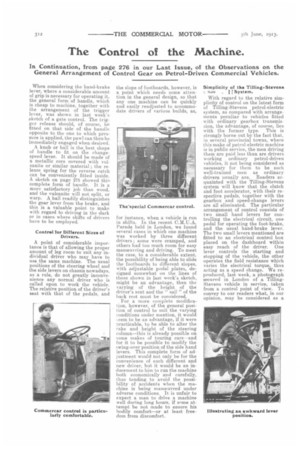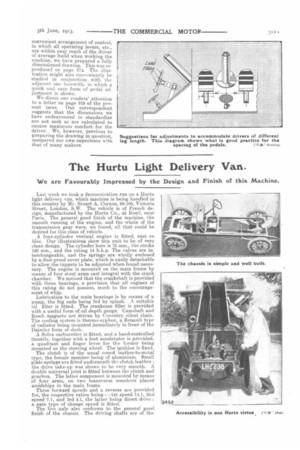The Control of the Machine.
Page 14

Page 15

If you've noticed an error in this article please click here to report it so we can fix it.
In Continuation, from page 276 in our Last Issue, of the Observations on the General Arrangement of Control Gear on Petrol-Driven Commercial Vehicles.
When considering the hand-brake lever, where a considerable amount of grip is necessary for operating it, the general form of handle, which is cheap to machine, together with the arrangement of the trigger lever, was shown in last week's sketch of a gate control. The trigger release should, of course, be fitted on that side of the handle opposite to the one to which pressure is applied, the pawl can-then be immediately engaged when desired.
A knob or ball is the best shape of handle to fit on the changespeed lever. It should be made of a metallic core covered with vulcanite or similar material ; the release spring for the reverse catch can be conveniently fitted inside. A sketch on page 275 showed this complete form of handle. It is a more satisfactory job than wood. and the vulcanite will not split, or warp. A ball readily distinguishes the gear lever from the brake, and this is a valuable point to make with regard to driving in the dark or in cases where shifts of drivers have to be employed.
Control for Different Sizes of Drivers.
A point of considerable importance is that of allowing the proper amount of leg room to suit any individual driver who may have to use the same machine. The usual positions of the steering wheel and the side levers on chassis nowadays. as a rule, do not greatly inconvenience any normal driver who is called upon to work the vehicle. The relative position of the driver's seat with that of the pedals, and
the slope of footboards, however, is a point which needs some attention in the general design, so that any one machine can be quickly and easily readjusted to accommodate drivers of various builds, as,
for instance, when a vehicle is run in shifts. In the recent C.M.U.A. Parade held in London, we found several eases in which one machine was worked by three different drivers ; some were cramped, and others had too much room for easy manceuvring and driving. To meet the case, to a considerable extent, the possibility of being able to slide the footboards to different slopes, with adjustable pedal plates, designed somewhat on the lines of those shown in last week's sketch, might be an advantage, then the varying of the height of the driver's seat and the " sail " of the back rest must be considered.
For a more complete modification, however, of the general position of control to suit the varying conditions under mention, it would ,.cem to be an advantage, if it were Practicable, to he able to alter the rake and height of the steering column—this is already possible on some makes of touring cars—and for it to be possible to modify the iwing-over position of the side hand levers. This complete form of adjustment would not only be for the convenience of each different and new driver, but it would be an inducement to him to run the machine both economically and carefully, thus tending to avoid the possibility of accidents when the machine is being manceuvred under adverse conditions. It is unfair to expect a man to drive a machine well during long hours, if snme attempt be not made to ensure his bodily comfort—or at least freedom from discomfort.
Simplicity of the Tilling-Stevens rSystem.
With regard to the relative simplicity of control on the latest form of Tilling-Stevens petrol-electric system, as compared with arrangements peculiar to vehicles fitted with ordinary gearbox transmission, the advantage, of course, lies with the former type. This is strongly borne out by the fact that, in several provincial towns, where this make of petrol-electric machine is in public service, the men driving them are paid less than are drivers working ordinary petrol-driven vehicles, it not being considered as necessary for them to be such well-trained men as ordinary driver a usually are. Readers acquainted with the Tilling-Stevens system will know that the clutch and foot accelerator, with their respective pedals, together with the gearbox and speed-change levers are all eliminated. The particular arrangement of control consists of two small hand levers for controlling the electrical circuit, one pedal for operating the foot-brake, and the usual hand-brake lever. The two small levers mentioned are fitted to an electrical control box placed on the dashboard within easy reach of the driver. One lever controls the starting and stopping of the vehicle, the other operates the field resistance which varies the electrical torque, thus acting as a speed change. We reproduced, last week, a photograph secured in London of a TillingStevens vehicle in service, taken from a control point of view. To convey to our readers what, in our opinion, may be considered as a
convenient arrangement of control, in which all operating levers, etc., are within easy reach of the driver of average build when working the machine, we have prepared a fully dimensioned drawing. This was reproduced on page 274. The illustration might also conveniently be studied in conjunction with the adjacent one herewith, in which a quick and easy form of pedal adjustment is shown.
We direct our readers' attention to a letter on page 319 of the present issue. Our correspondent suggests that the dimensions we have endeavoured to standardize are not such as are calculated to ensure maximum comfort for the driver. We, however, previous to preparing the drawing in question, compared our own experience with that of many makers.


























